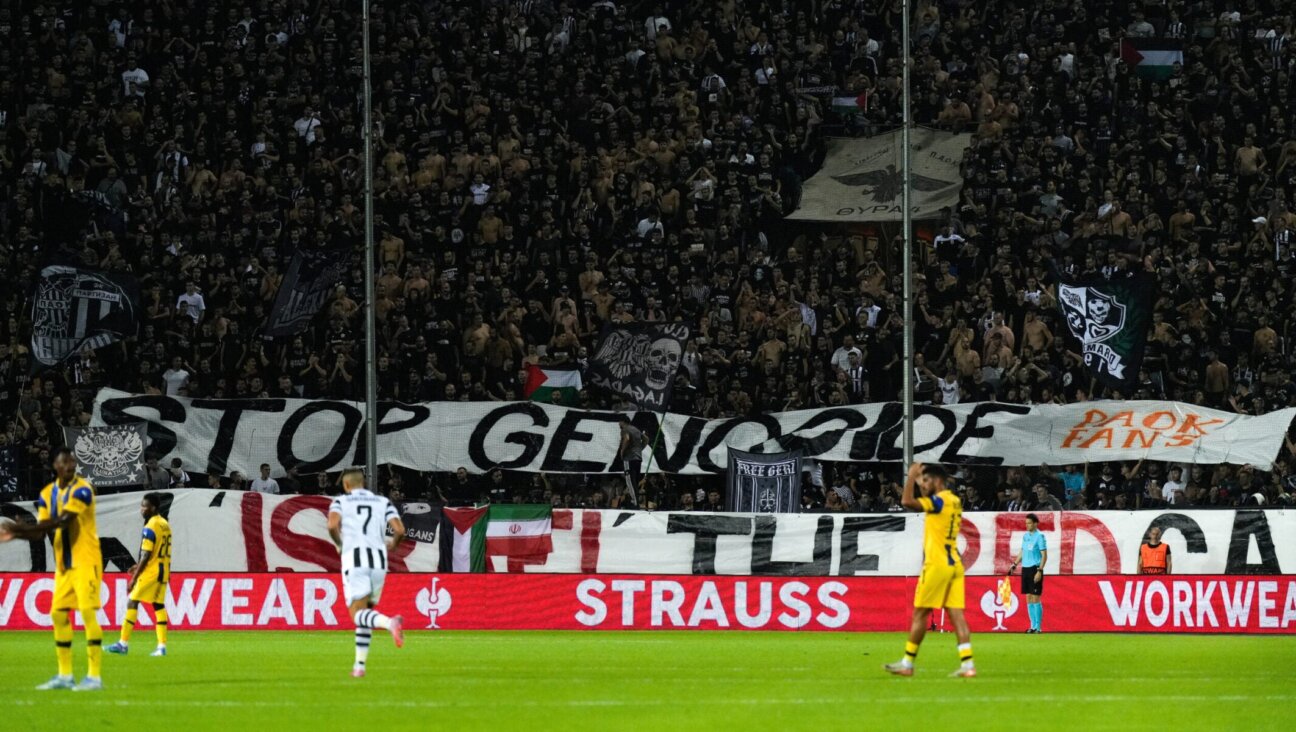Here’s How One Man Has Preserved the Milestones of Jewish History

Image by Courtesy of Jerry Klinger
Sign up for Forwarding the News, our essential morning briefing with trusted, nonpartisan news and analysis, curated by senior writer Benyamin Cohen.
Jerry Klinger’s epiphany came as he stood on a corner in Las Vegas, New Mexico. He was looking for Temple Montefiore, the first Jewish house of worship in the state, dating to 1884. All he could find was a building the Catholic Church used.
Turned out that Klinger was in the right place and had the right building, but there was nothing to mark its history as a synagogue. Then and there was born the idea for the Jewish American Society for Historic Preservation. From that point, Klinger’s interest in American Jewish history became a passion to which he has devoted more than 25 years.
In the years since, JASHP has worked with local groups to erect markers at dozens of sites in more than 25 states and four foreign countries.
Klinger is the JASHP. He created it. He funds it. JASHP’s home is the Washington, D.C., suburb of Rockville, Maryland, which happens to be Klinger’s address.
The goal of JASHP is to “give positive affirmation to the story of American Jewry,” he said. “We’re part of the American experience and part of its story,” Klinger said, not some “blood-sucking vultures who showed up after the Christians cleared the frontier. All of these things are designed to say just the opposite.”
JASHP has erected markers in locales stretching from Micanopy, Florida, where Moroccan Jewish immigrant Moses Elias Levy (1782–1854) sought to create a haven for oppressed European Jews, to the Cotopaxi, Colorado, graveyard for Russian Jewish immigrants who were part of a failed agricultural settlement from 1882 to ’84, and from Temple Israel, the first Jewish house of worship in New Hampshire, to Wild Horse Butte, Utah, remembering the daguerreotype photographs taken by Samuel Nunez Carvalho, a Sephardic Jew from Charleston, South Carolina, who accompanied the Fremont expedition of 1853–54 through the American West.
Klinger was also instrumental in the 2007 transfer of the remains of Theodore Herzl’s grandson, Stephen Theodore Norman, from the Adas Israel Cemetery in Washington., for reburial at Mount Herzl in Israel, and in arranging a grave marker for Adam Worth, aka Henry J. Raymond, a New York-born thief who chose to ply his trade in London to great notoriety and had been buried in a pauper’s grave.
Klinger has more than a dozen projects in the works, ranging geographically from the Caribbean to Mount Rushmore, South Dakota.
“The marker projects go to create simple visible facts on the ground. They create visible affirmation of forgotten history of American Jewish legitimacy and commonality as Americans. The markers affirm the incredible experience of American Jews and Jews as Americans. In mass cultures, where the Mona Lisa is appreciated by millions of visitors in 15 seconds or less, the markers are extremely effective,” Klinger said.
On a scorching day last June, Klinger participated in a ceremony on the grounds of the Atlanta History Center to dedicate a plaque honoring the courage shown a century earlier by Georgia’s governor, John Slaton, in commuting the death sentence of Leo Frank in June 1915. (Frank was kidnapped two months later from the state prison in Milledgeville and driven overnight to woods in Marietta, north of Atlanta, where he was lynched.)JASHP sponsored the plaque, along with the Atlanta History Center and the Georgia Historical Society. Rabbi Steven Lebow of Temple Kol Emeth, located in Marietta, organized events to mark the centennial of the Frank lynching. “Jerry Klinger, by erecting numerous markers and monuments to Jewish historical events, is a professional rememberer. Many of the diverse moments in Jewish history would have been forgotten if it had not been for the behind-the-scenes work that Jerry Klinger has done. In my own case, and in regards to Atlanta, the lynching of Leo Frank might be a painful, but ignored, moment in Southern history. By seeking ways to remember Leo Frank, Jerry has made sure that the drive for Frank’s ultimate exoneration will be neither ignored nor suppressed,” Lebow said.
How this 68-year-old retired financial services executive became a “professional rememberer” is its own story of American Jewish history. Klinger was the only child of Holocaust survivors (his Viennese father survived Buchenwald, and his Polish mother survived Bergen-Belsen). He grew up in Washington, D.C., where his parents settled after reaching America.
When Klinger was 6 years old, his father died from injuries suffered in the concentration camps.
Klinger said his father rejected religion— “He was very bitter after the war,” he said — but after his passing Klinger’s mother enrolled her son in a yeshiva. That religious education lasted until the ninth or 10th grade. “I was probably one of the worst students they had,” Klinger recalled.
Eventually, Klinger earned bachelor’s and master’s degrees from the University of Maryland and studied there for a doctorate in American studies, with the idea that he would become a teacher. Along the way, in the 1970s, Klinger did a stint in the Israel Defense Forces as a member of Machal-IDF-Volunteers, a unit of volunteers from outside Israel. He remembered “many nights sitting over machine guns” while stationed in the Sinai. College professors didn’t make much money, and Klinger figured he needed to get a better-paying job. He found one, eventually reaching the position of senior vice president with Bank of America Merrill Lynch.
In 1999, Klinger and his wife, Judy Klinger, were in Columbia, California, and wandered into a bookstore, where Klinger came across the “Pioneer Jews: A New Life in the Far West,” by Fred and Harriet Rochlin. “What the hell is a Pioneer Jew?” he remembered thinking aloud. A year later, the Klingers were visiting Santa Fe, New Mexico, when Klinger learned that Temple Montefiore was a short drive away. (That’s what he told his wife; in reality, it was more than 60 miles).
Klinger stood confused at the prescribed site. A local historian told him that he was in the right place, but that since 1950 the building had been a Catholic institution. “If I pay for a historic marker, would you be willing to work with me to historically identify the site?” Klinger asked. A couple of years later, during the High Holidays, a plaque was affixed to [the Cardinal Newman Society to remember the Jewish house of worship that had been there.
Klinger estimates that he has spent $500,000 on JASHP projects. “It’s not the marker that’s expensive. Those cost about $2,000. It’s the traveling, the trips,” he said.
The Klingers, who have been married for nearly 40 years, have three married sons and are awaiting the birth of their seventh grandchild. And Klingers says it is for his children and their children that he labors. Jews helped build America, and Klinger wants that remembered.“I just want everyone to get as much mileage out of this as we can,” Klinger said. “I’m concerned about the rising anti-Semitism. This is my way of protecting our grandchildren from people who will say, ‘You have no rights here, you’d didn’t help build this country.’”
Dave Schechter won a 2016 Simon Rockower Award for his feature story on the Communist past of Solomon Schechter’s daughter Amy.
















